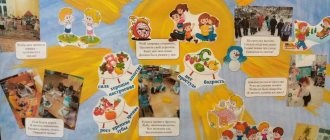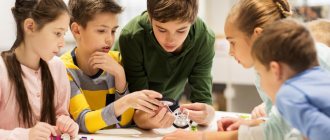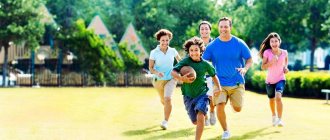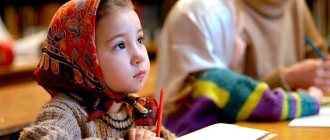Health-saving technologies in the educational process
Health-saving technologies in the educational process
Krivobokova Svetlana Panfilovna,
History and Social Studies Teacher
Health-saving technologies are a system of measures to protect and promote the health of students, taking into account the most important characteristics of the educational environment and the child’s living conditions that affect the child’s health.
Health-saving pedagogical techniques, methods, technologies that do not cause direct or indirect harm to the health of students and teachers and provide them with safe conditions for staying, studying and working in an educational environment.
Thus, all technologies and pedagogical techniques used by the teacher in the lesson can be assessed according to the criterion of their impact on the health of students.
The work of a school aimed at preserving and strengthening the health of students can only be considered complete and effective when health-preserving and health-forming technologies are fully, professionally and in a unified system.
Health-saving technologies are implemented on the basis of a person-oriented approach. Carried out on the basis of personal development situations, they are among those vital factors through which students learn to live together and interact effectively.
Health-saving pedagogical technologies should ensure the development of the child’s natural abilities: his mind, moral and aesthetic feelings, the need for activity, mastering the initial experience of communicating with people, nature, and art. “Health-shaping educational technologies”, as defined by N.K. Smirnova, are all those psychological and pedagogical technologies, programs, methods that are aimed at nurturing in students a culture of health, personal qualities that contribute to its preservation and strengthening, the formation of an idea of health as a value, and motivation to lead a healthy lifestyle. Health-saving technology, according to V.D. Sonkina is:
1. conditions for the child’s education at school (lack of stress, adequacy of requirements, adequacy of teaching and upbringing methods);
2. rational organization of the educational process (in accordance with age, gender, individual characteristics and hygienic requirements);
3. compliance of educational and physical activity with the age capabilities of the child;
4. necessary, sufficient and rationally organized motor mode.
Principles of health conservation
The concept of “health-saving technology” refers to a qualitative characteristic of any educational technology, showing how the problem of preserving the health of teachers and students is solved. These technologies must satisfy the principles of health conservation, which were formulated by N.K. Smirnov: • “Do no harm!”
- all methods, techniques, and means used must be justified, tested in practice, and not harmful to the health of the student and teacher.
• Priority of caring for the health of the teacher and student
- everything used must be assessed from the perspective of its impact on the psychophysiological state of participants in the educational process.
5. Continuity and continuity
- work is carried out not from time to time, but every day and in every lesson.
6. Subject-subject relationships
— the student is a direct participant in health-preserving activities in both content and procedural aspects.
7. Compliance of the content and organization of training with the age characteristics of students
— the volume of the teaching load and the complexity of the material must correspond to the age of the students.
8. Integrated, interdisciplinary approach
— unity in the actions of teachers, psychologists and doctors.
9. Success breeds success
— the emphasis is only on the good; In any act or action, the positive is first highlighted, and only then the shortcomings are noted.
10. Activity
- active inclusion, and any process reduces the risk of overwork.
.
Let's consider these groups of health-saving technologies.
Technologies that provide hygienically optimal conditions for the educational process.
The functional state of schoolchildren in the process of learning activities, the ability to maintain mental performance at a high level for a long time and prevent the premature onset of fatigue largely depend on the correct organization of the lesson and the level of its rationality. We must not forget about the hygienic conditions of the lesson, which affect the health of students and teachers.
The criteria for health conservation in the lesson, their brief description and the levels of hygienic rationality of the lesson are presented in the table.
| Health saving criteria | Characteristic |
| Classroom environment and hygiene | Temperature and air freshness, classroom and blackboard lighting, monotonous unpleasant sound stimuli |
| Number of types of learning activities | Types of learning activities: questioning, writing, reading, listening, telling stories, answering questions, solving examples, examining, cheating, etc. |
| Average duration and frequency of alternating activities | |
| Number of types of teaching | Types of teaching: verbal, visual, independent work, audiovisual, practical work, independent work |
| Alternation of types of teaching | |
| Availability and place of methods that promote activation | Method of free choice (free conversation, choice of method of action, freedom of creativity). Active methods (student in the role of teacher, researcher, business game, discussion). Methods aimed at self-knowledge and development (intelligence, emotions, communication, self-esteem, mutual esteem) |
| Place and duration of application of TSO | The teacher’s ability to use TSO as a means for discussion, conversation, discussion |
| Student's pose, alternating poses | Correct posture of the student; changing activities requires a change in posture |
| Availability, place, content and duration of healthy moments in the lesson | Physical training sessions, dynamic breaks, breathing exercises, eye exercises, massage of active points |
| Availability of motivation for students’ activities in the lesson | External motivation: assessment, praise, support, competition. Stimulation of internal motivation: desire to learn more, joy from activity, interest in the material being studied |
| Psychological climate in the classroom | Relationships in the lesson: teacher - student (comfort - tension, cooperation - authoritarianism, taking into account age characteristics); student - student (cooperation - competition, friendliness - hostility, activity - passivity, interest - indifference) |
| Emotional releases in the classroom | A joke, a smile, a humorous or instructive picture, a saying, an aphorism, a musical moment, a quatrain |
| Determined during observation by the increase in motor or passive distractions during educational activities | The moment of fatigue and decrease in educational activity |
| Lesson end tempo |
Technologies for optimal organization of the educational process and physical activity of schoolchildren
Analysis of scientific and methodological literature and our own practical experience allow us to identify four basic rules for constructing a lesson from the perspective of health-saving technologies.
Rule 1. Correct organization of the lesson
Firstly,
it is taking into account all the criteria for preserving health at a rational level.
Secondly,
The main goal of the teacher is to teach the student to request the necessary information and receive the required answer. And for this it is necessary to create in him interest, motivation for knowledge, learning, awareness of what he wants to know, readiness and ability to ask (formulate) a question. Asking questions is:
Thus, the quantity and quality of questions asked by a student serve as one of the indicators of his psychophysical state, psychological health, and also train his success in educational activities. The organization of a lesson must necessarily include three stages: - Stage 1: the teacher provides information (at the same time stimulates questions); - Stage 2: students formulate and ask questions - Stage 3: teacher and students answer questions. Lesson result
-
mutual interest that suppresses fatigue.
Rule 1. Proper organization of the lesson
Firstly,
This is taking into account all criteria for health conservation at a rational level.
Secondly,
The main goal of the teacher is to teach the student to request the necessary information and receive the required answer. And for this it is necessary to create in him interest, motivation for knowledge, learning, awareness of what he wants to know, readiness and ability to ask (formulate) a question. Asking questions is:
an indicator of the student’s involvement in the problem under discussion and, therefore, a good level of his performance;
manifestation and training of cognitive activity;
an indicator of adequately developed communication skills.
Thus, the quantity and quality of questions asked by a student serve as one of the indicators of his psychophysical state, psychological health, and also train his success in educational activities.
The organization of a lesson must necessarily include three stages: - Stage 1: the teacher provides information (at the same time stimulates questions); - Stage 2: students formulate and ask questions - Stage 3: teacher and students answer questions. Lesson result
-
mutual interest that suppresses fatigue.
Rule 2. Using perception channels
Features of perception are determined by one of the most important properties of individuality - functional asymmetry of the brain: the distribution of mental functions between the hemispheres. There are different types of functional organization of the two hemispheres of the brain: - left-hemisphere people
- with dominance of the left hemisphere. They are characterized by verbal-logical
style of cognitive processes, tendency to abstraction and generalization; - right-brain people
- dominance of the right hemisphere. This type has developed concrete-figurative thinking and imagination;
- equihemispheric people
- they do not have a pronounced dominance of one of the hemispheres.
Based on the preferred channels of information perception, they distinguish: - auditory perception;
— visual perception; - kinesthetic perception.
Knowledge of these characteristics of children will allow the teacher to present educational material in a language accessible to all students, facilitating the process of memorizing it.
Rule 3. Taking into account the students’ working capacity zone
It has been experimentally proven that the biorhythmological optimum of performance in schoolchildren has its peaks and valleys both during the school day and on different days of the school week. Performance also depends on the age characteristics of the children. The performance characteristics of students are presented in the diagrams.
Rule 4. Distribution of intensity of mental activity
When organizing a lesson, there are three main stages from the point of view of health conservation, which are characterized by their duration, volume of load and characteristic types of activities. The data is presented in table 1.3.
The effectiveness of students’ knowledge acquisition during the lesson is as follows:
20. 5-25th minute - 80%;
21. 25-35th minute - 60-40%;
22. 35-40th minute - 10%.
Almost all researchers agree that a lesson organized on the basis of the principles of health conservation should not lead to students finishing their studies with strong and pronounced forms of fatigue.
Fatigue
— a temporary deterioration in a person’s functional state that occurs as a result of work, expressed in a decrease in performance, in nonspecific changes in physiological functions and in a subjective feeling of fatigue. But fatigue should not be viewed only as a negative phenomenon. This is a protective, protective reaction of the body, a stimulator of its recovery processes and increased functionality. Indeed, constantly occurring and chronic fatigue, especially developing into overwork, has a negative effect on the body.
Intensity of mental activity of students during the lesson
| Part of the lesson | Time | Load | Activity |
| 1st stage. Working in | 5 minutes. | Relatively small | Reproductive, turning into productive. Repetition |
| 2nd stage. Maximum performance | 20-25 min. | Maximum reduction at 15 minutes. | Productive, creative, learning new material |
| 3rd stage. The Ultimate Rush | 10-15 min. | Small increase in performance | Reproductive, working out the key points of what has been covered |
Special studies have revealed that students who finish classes with severe and pronounced fatigue are diagnosed with nonspecific stress in the body - desynchronosis,
which is the basis for the formation of psychosomatic diseases. Consequently, by reducing fatigue, maintaining and restoring students’ performance, and controlling its changes during the learning process, we will contribute to health conservation.
Psychological and pedagogical technologies of health conservation
Relieving emotional stress
The use of gaming technologies, game-based training programs, original assignments and tasks, and the introduction of historical excursions and digressions into the lesson help relieve emotional stress. This technique also allows you to solve several different problems at the same time: provide psychological relief to students, give them developmental and educational information, show the practical significance of the topic being studied, encourage them to intensify independent cognitive activity, etc.
At the initial stage, these can be game tasks to generalize knowledge. For high school students, you can use tasks with fantastic or detective content, which also activate creativity. Tasks to summarize the material can be presented in the form of an advertisement for a particular law, phenomenon or theorem.
A good effect is achieved by using interactive educational programs that arouse constant interest among schoolchildren, while simultaneously relieving them of elements of stress and tension. Here we can also note the technique of using literary works that illustrate this or that phenomenon, law, etc.
Using proverbs when studying the concept of monotony of a function: “The further into the forest, the more firewood” (increasing), “The further you put it, the closer you take it” (decreasing). At this moment, the learning process is, as it were, hidden from the students; they perceive this as some deviation from the topic, which also allows them to relieve accumulated tension. In addition, the introduction of literary or historical digressions into the lesson contributes not only to psychological relief, but also to the establishment and strengthening of interdisciplinary connections, as well as educational goals.
Creating a favorable psychological climate in the classroom
Perhaps one of the most important aspects is the psychological comfort of schoolchildren during the lesson. On the one hand, this solves the problem of preventing students from getting tired, on the other hand, there is an additional incentive to reveal the creative potential of each child.
A friendly atmosphere in the lesson, a calm conversation, attention to every statement, a positive reaction from the teacher to the student’s desire to express his point of view, tactful correction of mistakes, encouragement for independent thinking, appropriate humor or a small historical digression - this is not the entire arsenal that can to have a teacher who strives to reveal the abilities of each child.
Students enter class not with the fear of getting a bad grade or reprimand, but with the desire to continue the conversation, demonstrate their knowledge, and gain new information. During such a lesson, there is no emotional discomfort even if the student failed to cope with something or was unable to complete something. Moreover, the absence of fear and tension helps everyone to free themselves internally from unwanted psychological barriers, speak out more boldly, and express their point of view.
In addition, each student reacts more calmly to the assessment received if he himself understands its validity. Assessing his mistakes, the student immediately sees ways to correct them. Failure in class, perceived as temporary, becomes an additional incentive to be more productive at home and in the classroom. The teacher encourages the student’s desire for self-analysis and strengthens his confidence in his own capabilities.
It should be noted that in an atmosphere of psychological comfort and emotional elation, the performance of the class increases noticeably, which ultimately leads to better knowledge acquisition and, as a consequence, to better results.
At the end of the lesson, students leave the class in a good mood, since during this time there were practically no negative factors.
Health protection and promotion of a healthy lifestyle
Protecting the child’s health involves not only creating the necessary hygienic and psychological conditions for organizing educational activities, but also preventing various diseases, as well as promoting a healthy lifestyle.
Research shows that the most dangerous factor for a person’s health is their lifestyle. Consequently, if you teach a person from school years to be responsible about his health, then in the future he has a greater chance of living without getting sick. Today it is very important to introduce health issues into educational subjects. This will not only deepen the knowledge gained and make interdisciplinary connections, but also show the student how the material being studied relates to everyday life, and teach him to constantly take care of his health.
Thus, in physics lessons, almost any topic studied can be used to highlight certain facts that contribute to the formation of the correct attitude of students towards their health. This also includes the prevention of childhood injuries and accidents associated with the child’s incorrect behavior in various everyday situations.
Integrated use of person-centered technologies
Among health-saving technologies, we can especially highlight the technologies of person-centered learning, which take into account the characteristics of each student and are aimed at the fullest possible disclosure of his potential. These include technologies for project activities, differentiated learning, collaborative learning, and various gaming technologies.
Personally-centered learning involves the use of various forms and methods of organizing educational activities.
At the same time, the teacher faces new tasks: creating an atmosphere of interest for each student in the work of the class; encouraging students to express themselves and use different ways of completing tasks without fear of making mistakes; creating pedagogical communication situations in the classroom that allow each student to show initiative, independence, and selectivity in ways of working; creating an environment for the student’s natural self-expression.
To solve these problems the following components can be used:
creating a positive emotional mood for the work of all students during the lesson;
use of problematic creative tasks;
encouraging students to choose and independently use different ways of completing tasks;
the use of tasks that allow the student to choose the type, type and form of the material (verbal, graphic, conditionally symbolic);
reflection. Discussion of what worked and what didn’t, what were the mistakes, how they were corrected.
Based on the above, it becomes obvious that these technologies make it possible to simultaneously solve the problems of protecting the health of schoolchildren in both psychological and physiological aspects. It is thanks to the use of modern technologies that it is possible to provide the most comfortable conditions for each student, take into account the individual characteristics of each child, and therefore minimize negative factors that could harm his health.
This involves the use of individual tasks of different types and levels, individual pace of work, choice of educational activities, students’ personal choice of block-modular systems of the educational process, educational games, project activities, collective activities, specialization of education, medical, psychological and pedagogical support for students.
A healthy lifestyle does not yet occupy first place in the hierarchy of human needs and values in our society. But if we do not teach children from a very early age to value, take care of and strengthen their health. If we demonstrate a healthy lifestyle by personal example, then only in this case can we hope that future generations will be healthier and developed not only personally, intellectually, spiritually, but also physically. If they used to say: “In a healthy body there is a healthy spirit,” then the one who says that without the spiritual cannot be healthy cannot be mistaken. Observations show that the use of health-saving technologies in the educational process allows students to more successfully adapt to the educational and social space, reveal their creative abilities, and the teacher to effectively prevent antisocial behavior. Bibliography
28. 1. Babansky Yu. K. “Methodological foundations for optimizing the educational process” 1982. – 480 s.
29. Kovalko V.I. Health-saving technologies in elementary school. 1-4 grades. M.: “VAKO”, 2004, 296 p. — (Pedagogy. Psychology. Management).
30. Kukushin V. S. Theory and methods of teaching. - Rostov n/d.: Phoenix, 2005. - 474 p.
31. Menchinskaya E.A. Fundamentals of health-saving education in elementary school: Methodological recommendations for overcoming student overload / E.A. Menchinskaya. - M.: Ventana-Graf, 2008. - 112 p. — (Pedagogical workshop).
32. Our choice is health: leisure program, development of activities, recommendations / author-comp. N. N. Shaptseva. – Volgograd: Teacher, 2009. – 184 p.
33. Orekhova V. A. Pedagogy in questions and answers: textbook. Benefit. – M.: KNORUS, 2006. P. 147
34. Smirnov N.K. Health-saving educational technologies in modern school. – M.: APK and PRO, 2002. – p. 62.
35. Sovetova E. V. Effective educational technologies. – Rostov n/Don: Phoenix, 2007. – 285 p.
36. Shchukina G.I. “Activation of students’ cognitive activity in the educational process.” M., Enlightenment. – 220 s.
37. https://www.shkolnymir.info/
. O. A. Sokolova. Health-saving educational technologies
Health-saving technologies - what is it?
What are health-saving educational technologies (HET)?
The founder of this concept was N.K. Smirnov, who gave the following definition: “This is a set of forms and techniques for organizing the educational process without harming the health of the child and the teacher.”
In practice, such technologies include those that meet the following requirements:
- Create normal conditions for learning at school (lack of stress for the child, creation of a friendly atmosphere, adequacy of the requirements for the child).
- Take into account the age capabilities of the child. That is, when distributing physical and educational activity, age is taken into account.
- They rationalize the organization of the educational process (in accordance with the psychological, cultural, age, gender, and individual characteristics of each child).
- Provide sufficient motor mode.
Fifteen health-saving technologies for school
- A physical education minute is a dynamic pause during intellectual activities. It is carried out as children become tired. This could be breathing exercises, eye exercises, or light physical exercises. Time - 2-3 minutes.
- Finger gymnastics - used in lessons where the student writes a lot. This is a short warm-up for your fingers and hands.
- Gymnastics for the eyes . Conducted during intellectual activities. Time - 2-3 minutes.
- Changing types of activities is the expedient alternation of different types of activities in the lesson (oral work, written work, game moments, etc.). It is carried out with the aim of preventing rapid fatigue and increasing the interest of students.
- Articulation gymnastics . This includes work on speech development, counting rhymes, rhythmic poems, oral retellings, choral repetitions, which are used in lessons not only for mental, psychological and aesthetic development, but also to relieve emotional stress.
- Games . Any kind of games: didactic, role-playing, business - games are designed to solve not only educational problems. At the same time, they develop creative thinking, relieve stress and increase students’ interest in the learning process.
- Relaxation - carried out during intellectual activities to relieve tension or prepare children to perceive a large block of new information. This could be listening to calm music, sounds of nature, or mini-auto-training.
- Aesthetic technologies . This includes going to museums, visiting exhibitions, working in clubs, that is, all activities that develop the child’s aesthetic taste.
- Office decoration . The sanitary and hygienic condition of the premises in which classes are held is also considered a health-saving technology. This takes into account not only cleanliness, but also temperature, fresh air, the presence of sufficient lighting, and the absence of sound and other stimuli.
- Students' poses . If in elementary school teachers still monitor the posture and correct position of the child at the desk while writing or reading, then in high school this is often neglected. At the same time, posture is formed in a person only by the age of 15-17 years. And incorrect postures that a child takes during lessons can lead not only to poor posture, but also to rapid fatigue, wasted energy, and even illness.
- Technologies that create a positive psychological climate in the classroom. This includes not only methods and techniques that increase motivation, but also techniques that teach teamwork, attentiveness, improve the microclimate in the team, and promote personal growth and self-esteem.
- Emotional releases are mini-games, jokes, moments of humor, entertaining moments, in general, everything that helps relieve tension under heavy emotional and intellectual stress.
- Conversations about health . In addition to the mandatory life safety and physical education courses, one should strive to ensure that the lessons in one form or another address issues related to health and attracting people to a healthy lifestyle. It is most convenient to do this in the practical part of the lessons, deliberately simulating situations related to health and safety. For example, in Russian language lessons you can choose texts related to a healthy lifestyle for exercises and dictations.
- Communication style between teacher and students. Modern standards require teachers to be democratic and tactful. The most important thing is to provide the student with mental comfort and a sense of security, which will allow him to study with pleasure, and not under duress.
- Working with parents . The continuity of the operation of the PTA cannot be monitored without the participation of parents. They are the ones responsible for maintaining the daily routine, diet, and monitoring the child’s physical health. Conversations during class hours, speeches by medical workers at parent-teacher meetings—this also applies to health-saving technologies.
This is a list of only the most popular and generally available health-saving technologies that any subject teacher can use during the organization of the educational process.
Classification of health-saving technologies
Specialists developing this area of methodology offer several classifications of health-saving technologies that take into account different aspects. The most general classification looks like this:
- Technologies that provide hygienically optimal learning conditions.
- Technologies for teaching a healthy lifestyle.
- Psychological and pedagogical technologies used by teachers in class and extracurricular activities. This refers to the teacher’s influence on students at every stage of the lesson and during extracurricular activities.
- Corrective technologies.




